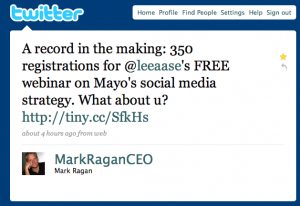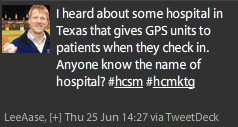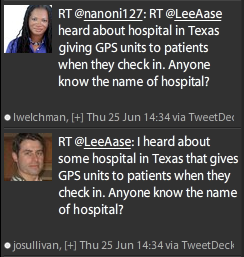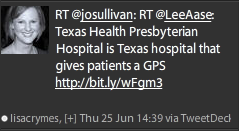Here are the slides and the video Webcast window for Tweetcamp III (#tweetcamp3), which will be held Monday, July 13, 2009 from 3-4 EDT. Please note that the video window will not be live until the time of the program, but you may preview the slides if you wish.
Update 4:30 p.m. CDT July 13: We had some technical difficulties with uStream.tv (I’m fairly certain they were related to our firewall) so we had to do Tweetcamp III via phone conference instead of Webcast. I will probably do did an encore (or take a Mulligan) tonight from home that you can see below.
Update 7:30 p.m. CDT July 13: Hit play on the video below, and then you can follow along as I narrate the slides.
Here is the video window:
Credits:
- Shwen Gwee (@shwen) coined (to the best of my knowledge) the phrase “Tweet Cred.” A term that needs no explanation. It’s just perfect.
- Thanks to @vmontori @2healthguru @mrstreme @kamichat for providing real-time feedback during my first uStream.tv experiment. If we get the audio level right in Tweetcamp, it will be because of their help.
- In addition to those listed above (and @EdBennett, @LeeAase and @MayoClinic), here’s a baker’s dozen of additional health-related Tweeps you might want to consider following to get started in Twitter: @danamlewis, @MeredithGould, @DaphneLeigh, @tstitt, @stephaniethum, @healthblawg, @consultdoc, @lsaldanamd, @crgonzalez, @brendafinkle, @mkmackey, @HealthSocMed, @ReedSmith. As you see who they are re-tweeting, you’ll discover even more interesting people to follow.
- Finally, clicking this link to see the #tweetcamp3 chatter will identify some others with shared interests. After all, you all participated in the same event.
I welcome your feedback, either in the comments below or via a tweet using the #tweetcamp3 hashtag.



